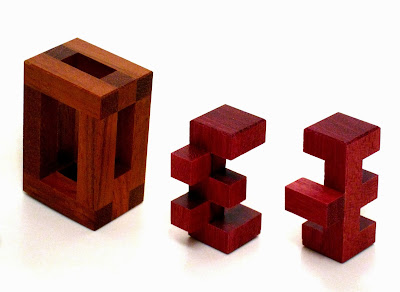HALT
Designer
Stephane Chomine. Stephane has to-date a whopping 452 designs, click here to see them.
Pelikan. Online seller PuzzleMaster of Canada are retailing them at CA$53.99.
Type & Classification
Interlocking, sequential movement
Dimensions
6.5cm (Length) x 6.5cm (Width) and 9.0cm (Height). Nice size for the hands.
Materials & Construction
A combination of 2 solid hardwoods. The frame is Wenge and the pieces are Maple. Excellent construction, fit and finishing throughout. All the pieces are very precisely cut and came to me rather snugly fit. As usual, it spent a good 5 days in my camera dry box to loosen up all the pieces before play.
Overview
Look at the photos above and you can probably tell why the puzzle is called HALT. Only 2 pieces are all is needed to spell out the 4 letters H.A.L.T on the 4 sides of the frame.
Object is to remove the 3 irregular shaped pieces within the rectangular frame and re-assemble them. It took me about 25 minutes to get the first piece out. This was the most difficult part but thereafter, pretty easy to remove the 2nd and 3rd pieces.
The putting back together was much harder tho'. For this sort of burr/interlocking puzzles, I would normally take photos of my steps during disassembly so that I can retrace my steps but in this case, somewhere along the way, I got lost and the photos were of little help. After some time of fiddling and trial and error, I managed to get the pieces back into the frame. Thank goodness its only 3 pieces otherwise I would have had a much harder time.
Difficulty Level
This is a 2-solution level 21.8.2 puzzle requiring 21 moves to remove the first piece and a further 8 to remove the second!; even though after the first piece is out, there are only 2 pieces left in the frame. Largely due to the notches and protruding blocks glued to form the odd-shaped pieces. Although 21 moves may seem like a lot, it is not as difficult as one would imagine, although the re-assembly portion is much more difficult.
One of those interlocking burrs that look rather intimidating from the outside. But once you settle into the puzzling, really it is quite manageable.















